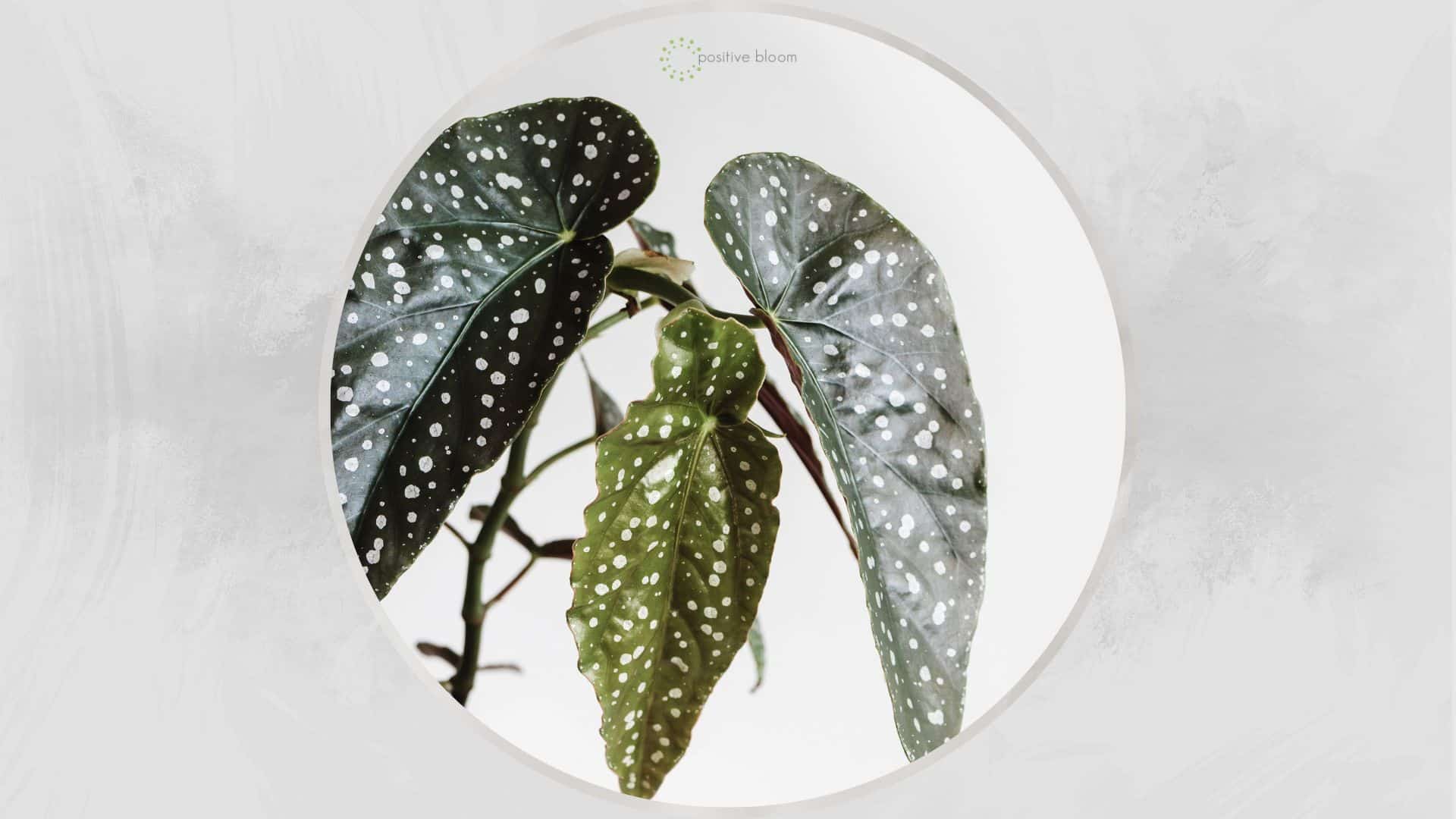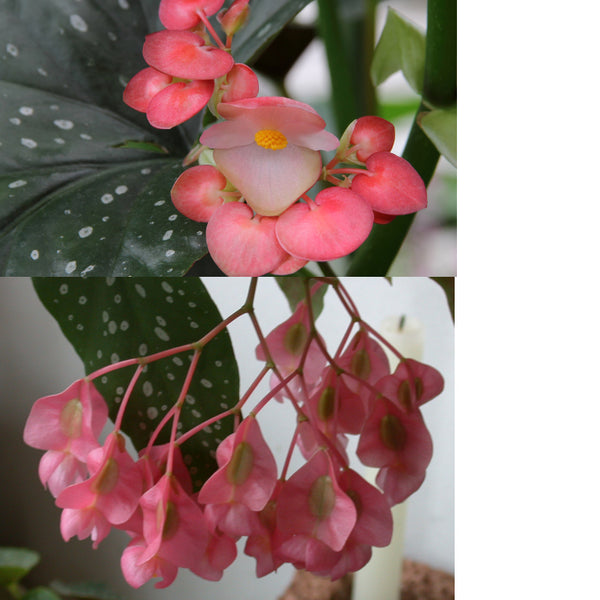The name Angel Wing Begonia can be VERY confusing. Luckily their care is much simpler than trying to work out which Angel Wing begonia you have. This guide will help with both. In fact this family of begonia are the hardiest, easiest-care of them all (and there are a LOT of different types of begonias). However, what you may have been told is an Angel Wing (sometimes called a Dragon Wing), is actually the common name used for the leaf shape rather than the exact variety, cultivar or hybrid you have.
The Ultimate Guide to Angel Wing Begonia Temperature Tolerance
As a proud angel wing begonia owner, keeping your prized plant happy and healthy is a top priority. But with their tropical origins, these beauties can be quite particular about temperature. Understanding your angel wing begonia’s ideal temperature range is crucial for helping it thrive indoors.
In this comprehensive guide, we’ll dive into everything you need to know about angel wing begonia temperature tolerance We’ll cover
- Their natural habitat and temperature needs
- Signs of temperature stress
- The optimal temperature range
- Daytime vs nighttime temperatures
- Managing seasonal shifts
- Creating the perfect indoor climate
- Transitioning between indoor and outdoor
- Common mistakes to avoid
- And much more!
Whether you’re a beginner or seasoned angel wing caretaker, this guide will equip you with the knowledge to keep your plant flourishing in any season. Let’s get growing!
Natural Habitat and Temperature Needs
Hailing from the tropical climates of South America, angel wing begonias thrive in warm, humid environments. In their native habitat, temperatures range from 65°F to 75°F (18°C to 24°C) during the day, with slightly cooler nights.
This consistent warmth keeps their metabolism humming, allowing for vigorous growth. As tropical plants, sudden temperature drops or extremes can shock them. Understanding their natural climate helps us recreate ideal conditions indoors.
Signs of Temperature Stress
If temperatures dip too low or flare too high, your angel wing begonia will exhibit symptoms of stress. Here’s what to watch for:
- Wilting or drooping leaves
- Curled or crispy leaf edges
- Brown spots or scorched leaves
- Increased leaf drop
These are clear indicators that the temperature is not within your plant’s comfort zone. Time to make some adjustments!
The Optimal Temperature Range
To keep your angel wing begonia thriving, aim for a temperature range of 65°F to 75°F (18°C to 24°C). At these consistent warm temperatures, you’ll see vigorous growth and lush foliage.
The temperature should not fall below 60°F (15°C) at night. Cool evenings allow the plant to conserve energy. Aim to keep the environment as stable as possible.
Managing Daytime and Nighttime Temperatures
During the day, temperatures in the 65-75°F range give your plant the energy it needs for photosynthesis. At night, a 10-15 degree dip is beneficial, mimicking its native climate.
Ensure daytime warmth with proper heating and sunlight exposure. Draw curtains at night to prevent heat loss from windows. Move plants away from drafty spots. A programmed thermostat can provide temperature stability.
Coping with Seasonal Temperature Shifts
As seasons change, so do indoor temperatures. Here are some tips to help your angel wing begonia adjust:
Winter:
- Move plant away from cold windows
- Use curtains, space heaters to maintain warmth
- Avoid placing near heating vents
Summer:
- Shift plant away from hot windows
- Use fans, AC to prevent overheating
- Keep out of direct air flow
Transition gradually when moving into outdoor spaces. Avoid sudden temperature swings.
Creating the Perfect Indoor Climate
Recreating the humid, tropical climate angel wings love is achievable indoors. Follow these tips:
- Provide bright, indirect light near windows
- Maintain 40-60% humidity with a humidifier
- Choose a draft-free spot with stable temps
- Use a thermometer to monitor temperature
- Adjust heating/cooling devices as needed
By optimizing these factors in your plant’s environment, you can keep your angel wing begonia healthy and strong!
Should You Place it Outside?
During warm months, moving your angel wing begonia outdoors can be rejuvenating. Just ensure temperatures remain ideal.
Avoid placing in direct sunlight, which can scorch leaves. Bring plants back inside well before night temperatures drop below 60°F (15°C) in autumn.
Gradually transition indoor plants outside over 7-10 days, allowing them to adjust to the changed environment.
Common Mistakes to Avoid
While caring for angel wing begonias, there are some common missteps. Be aware of:
-
Allowing temperatures to fluctuate wildly
-
Exposing plant to drafty windows or vents
-
Letting indoor climate get too hot or too cold
-
Failing to monitor day and night temperatures
-
Making sudden seasonal transitions
-
Placing plant in direct outdoor sunlight
By avoiding these pitfalls and keeping a close eye on temperatures, you’ll be rewarded with a thriving angel wing begonia that dazzles with vibrant leaves and abundant blooms!
To recap, angel wing begonias require warm, stable temperatures between 65-75°F (18-24°C) to thrive. Cooler nights around 60°F (15°C) are ideal. Monitor your plant for signs of temperature stress. Adjust heating, cooling, sunlight exposure, and location to maintain the perfect climate indoors and out. With proper temperature care, your angel wing begonia will flourish!

Can you create seeds from a flowering Begonia?
Begonias are monoecious, meaning they produce separate male and female flowers on the same plant (compare them using the photos below), so yes, you can create seeds from a flowering begonia.
However, the male and female flowers do not normally bloom at the same time, so it can be a process over time, collecting the pollen from the male flowers (which normally bloom first) then pollenating the female flowers, and later harvesting and planting the seeds. If youre interested in creating and growing from seed, heres a good how to create begonia seeds from the American Begonia Society.
 Above: TOP male flowers and BOTTOM female begonia flowers.
Above: TOP male flowers and BOTTOM female begonia flowers.
How tall do Angel Wing begonia grow?
Angel Wing begonia are a type of Cane begonia, named after their segmented, bamboo-looking stems. Yes, your little spotted indoor plant buddy could end up VERY tall (1.5 metres+) depending on which one you have, but those heights are more typical when grown in ideal conditions outdoors.
Indoors, a good 30cms or so is more realistic but Ive seen many a photo of them touching the ceiling growing indoors. I keep mine on the short side and regularly take cuttings, propagate them in water, and once rooted, re-plant them back in with the mother plant, creating much bushier plants. Left to their own devices the stems become surprisingly thick and boy can they shoot up! I also find mine stay bushier in general when kept shorter, but can get leggy if I let them get too tall.
Angel wing begonias, how to grow and bloom indoors (@gardeningthroughtheseasons )
FAQ
How cold can an Angel Wing Begonia tolerate?
Warmth is appreciated by the Angel Wing begonia. Around 18 to 30 degrees (65-85 Fahrenheit), is a good temperature range, but they will handle lower temperatures indoors over winter provided the rest of the conditions are ideal. I aim to keep mine above 15 degrees.
What temperature is too cold for begonias?
-
General Cold Tolerance:Most begonias are not cold-hardy and prefer warm, humid conditions.
-
Temperature Threshold:The American Begonia Society considers 55°F (13°C) the lower end of their comfort zone, but some hybrids may be more cold-tolerant.
-
Signs of Cold Stress:If temperatures drop below 55°F (13°C), you might notice your begonia sulking, with leaves turning yellow or dropping, and growth slowing down.
-
Protecting Begonias in Cold Weather:
- Move Indoors: If you have begonias outside, consider moving them indoors where the temperature is more stable, such as a sunroom or bright windowsill.
- Insulate Pots: If you can’t move them indoors, wrap the pots with bubble wrap or use a plant cozy to help insulate the roots.
- Provide Protection: Use frost cloths or other protective measures to shield begonias from frost damage.
- Move Indoors: If you have begonias outside, consider moving them indoors where the temperature is more stable, such as a sunroom or bright windowsill.
-
Tuberous Begonias:In areas that freeze during the winter, tuberous begonias must be dug up and the tubers stored indoors for the winter after the first light frost.
-
Wax Begonias:Wax begonias are surprisingly resilient, able to withstand mild frost down to 30°F (-1°C).
Can I put my Angel Wing Begonia outside?
Angel wing begonias are typically grown as houseplants, though they will do okay outdoors in part shade. They’re moderate growers, reaching heights of 2 to 3 feet and widths of about 2 feet.
When should I bring my begonias inside?
Especially in regions with harsh climates and low winter temperatures, it is best to bring even so-called hardy begonias indoors after the first light frost.
